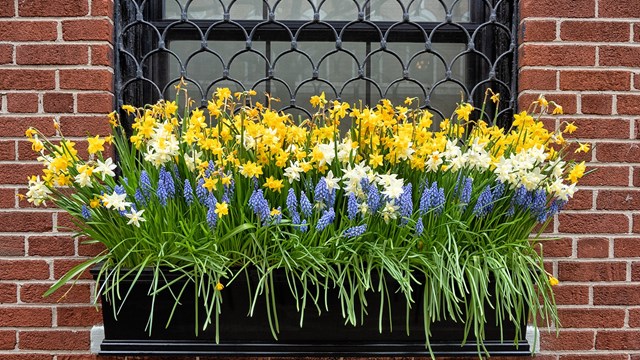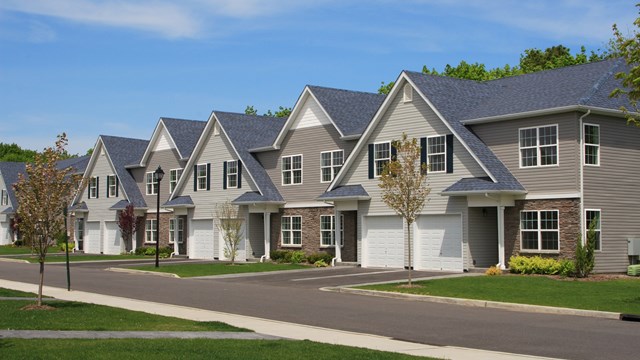New Jersey is only 166 miles long and 65 miles across at its widest point, with less than 8,000 square miles in total land area. Compact as it is, the Garden State nevertheless experiences a full range of seasonal changes in all five of its distinct regions: Northern, Central, the Pine Barrens, Southwest, and Coastal. From the famous Jersey shore to the Kittatinny Mountains, New Jersey is no stranger to both hot humid summers and freezing winters. With 40 to 51 inches of rainfall—and no less than five tornadoes annually—this little state sees some big weather.
Establishing and/or maintaining an attractive landscape in a climate this varied is a definite challenge, perhaps even more so for multifamily environments in urban or suburban areas. When you factor in the additional foot traffic, pets, liter and pollution commonly associated with multifamily dwellings, it can be tough for plants, trees, and flowers to survive, let alone thrive.
Down the Garden Path
In an effort to save money, some boards and grounds committees put a great deal of time and energy into do-it-yourself landscaping, rather than hiring professionals. Weeding flowerbeds and raking leaves is one thing; but if a committee chooses the wrong type of plant, or puts a shrub, tree, or flowerbed in the wrong place, the poor results may be a very costly mistake. In addition to being an eyesore, misguided plantings can result not just in replacement costs for dead or damaged plants, but even repair costs for structural damage to roofs, foundations, or pavement.
This is not to say that a volunteer landscaping or gardening committee is a bad idea—far from it. If your community includes folks who truly enjoy the physical labor associated with weeding, planting, and so forth, they can absolutely participate—but perhaps under the guidance of a landscaping professional hired on a consulting basis to develop a sound plan with site-appropriate plants. With the New Jersey climate, plants that can adapt to extremes in the weather are an obvious choice, but investing in a consultant to get a proper plan in place can also save a considerable sum in the long run.
Another nearly-guaranteed money-saver for interested board members is self-education. The New Jersey Cooperative Extension Master Gardeners Program, (http://rutgers.edu/master gardeners/helplines.asp), provides educational outreach to the general public. Visiting this informative site can provide a solid foundation of research-based information and help a board formulate a specific Q&A before calling a professional landscaper.
Bringing an Expert On Board
The experts agree, the best way to avoid costly landscape mistakes is to work with a professional. “A true professional will not be a “yes-man” when it comes to discussing options, but rather a provider of educated answers,” says Patrick Cramer, commercial sales director for By Design Landscapes in Lakewood.
Once the board has a rough idea of their vision, their expectations, and their budget constraints, it is time to reach out to a professional. Cramer recommends developing a plan over the contract term with the chosen vendor. “Work on first fixing irrigation problems on site,” he says. “Next begin a turf repair plan, and finally develop a landscape enhancement plan to help beautify the site.”
Neil LeBlond, senior landscape designer for High Tech Landscapes, Inc. in Branchburg, says the most common mistakes he sees in both residential and commercial landscaping is overplanting, and/or choosing varieties that will outgrow the immediate space.
“Landscape architects and designers are trained to create plans that will utilize plants whose natural growth habit is in proportion to the space the plant will occupy when it reaches maturity,” he explains. “If proper spacing is not used during design and installation, overgrowth will result. Designers use architectural conventions that relate to mature size when creating a drawing to determine spacing.” LeBlond cautions that when proper spacing in not used during the initial designing phase, it sets in place a cycle of overgrowth and improper, aggressive pruning resulting in aberration of the natural growth habit. Not only does this ruin the design aesthetic, it also incurs increased maintenance cost until the damage results in replacement of the affected plants.
Cramer also cites a lack of proper information on which type of plant material should be placed in specific areas, and he agrees with LeBlond when he states, that “Many don't give consideration to the growth habits and mature size of what they're planting. People are most familiar with the plants they see at local nurseries and home goods stores, which is usually displayed in small, manageable containers at the time of purchase.” But much like the cute puppy or kitten that seems so little and unobtrusive but then morphs into a full-grown dog or cat, plants mature—and can impede walking paths, building foundations, roof lines and gutters as they grow to full size. “The costly outcome is usually the removal of the plant material along with the additional expense to re-plant the proposed area properly.”
These issues are particularly acute when it comes to tree placement. When an HOA wants trees included in a landscape design, it pays to consult a certified tree expert to make sure both the species proposed and their intended places are appropriate.
Ryan Duff is a state-certified arborist with the Wyckoff, New Jersey offices of Almstead Tree & Shrub Company. He explains that an arborist will have a deeper understanding of proper tree selection and planting techniques. “On larger projects, arborists work in coordination with landscape architects and landscapers to insure that the final project will stand the test of time, and be as maintenance-free as possible,” Duff says.
If an association does not have funding for a professional landscape contractor, LeBlond recommends doing as much research as possible beforehand, and hands-on project management during the installation of new landscaping to avoid issues that may have been missed, and/or unforeseen changes. He also favors a two prong proposal, “Proposed planting designs should always be accompanied by a maintenance program,” he says. “The program should provide photographs of the desired look, and tips on proper pruning and nutrition that will ensure plant vigor and longevity.”
We Need A Do-Over
If a board is already dealing with an overgrown landscape problem, there are ways to make corrections. “Rejuvenate pruning or ‘winter pruning” is always the less expensive/aggressive option,” says Cramer. “Most deciduous material, plants, and trees can be severely reduced in height and shape over the dormant winter months. This option is considerably less expensive than removing, designing, and installing new plant material throughout an entire property.”
LeBlond recommends investigating restorative pruning techniques such as plunge pruning, or proportional canopy reduction over a number of growing years. He also suggests applications of certain chemical products that retard growth, and reduce the need for frequent pruning. Replanting will always be the most costly option.
Besides overgrowth of trees and plants, Duff says he often deals with soil compaction from foot traffic in multifamily environments. “Foot traffic tends to find the path of least residence,” he explains. “Sometimes that means cutting the corners and walking under trees and shrubs.” Once these areas become compacted and sunken, they tend to collect water, which reduces oxygen and can result in damaged or killed root systems. “An arborist using an Air Spade™ can correct compaction by breaking up the compacted soil with air pressure and incorporating compost or compost tea,” he says.
Expert Tips And Advice
LeBlond has a short list of recommendations to enhance landscaping while saving community funds. “Provide adequate space for future growth, and know the ultimate size of a plant BEFORE it is planted. Whenever possible, use native plants, and xerophytic plants. Invest in soil improvements, and begin to manage plantings immediately,” he says. He also favors plants that have a “dwarf growth habit” to avoid overgrowth and all the trouble that can spell.
Duff agrees, and offers up a few additional tips: “Take the time to mulch properly—the benefits of that cannot be overstated.” He also suggests maintenance and landscape crews watch for salt damage to plants and shrubs after harsh winter weather. “ An arborist can recommend applications with a product like Humate to bind the excess sodium, making it unavailable to the plants,” he explains. “Soil testing is particularly helpful in determining salt levels in the soil.” Lastly, Duff recommends staying on task with pruning, even when everything “seems fine.” Skipping a year will only result in the need for more dramatic—and more expensive—cuts at a later date.
Cramer also recommends fertilization programs to improve soil quality, and annual soil testing. He also suggests a review and update of a community’s lawn maintenance contract specifications on an annual or bi-annual basis. “Frequently contractors bid on contracts that are more than 10 years old,” he states.
The Last Word
Cramer has a final word for HOAs in pursuit of beautiful and healthy landscaping, and that word is communication. “Use your resources, and listen to the professionals,” he says. “Press for weekly or monthly updates on conditions from site supervisors and property managers. Schedule walk-throughs and board meetings with the contractor to keep the community up to speed on what is going on, and what can be improved.”
Landscaping is not a “one and done” project but an ongoing endeavor requiring time, talent, and funding to create and maintain the best community appearance all year long. Taking advantage of expert recommendations and suggestions is the smart way to enhance and preserve both the beauty and the investment in any community’s landscaping.
Anne Childers is a freelance writer and a frequent contributor to The New Jersey Cooperator.







Leave a Comment